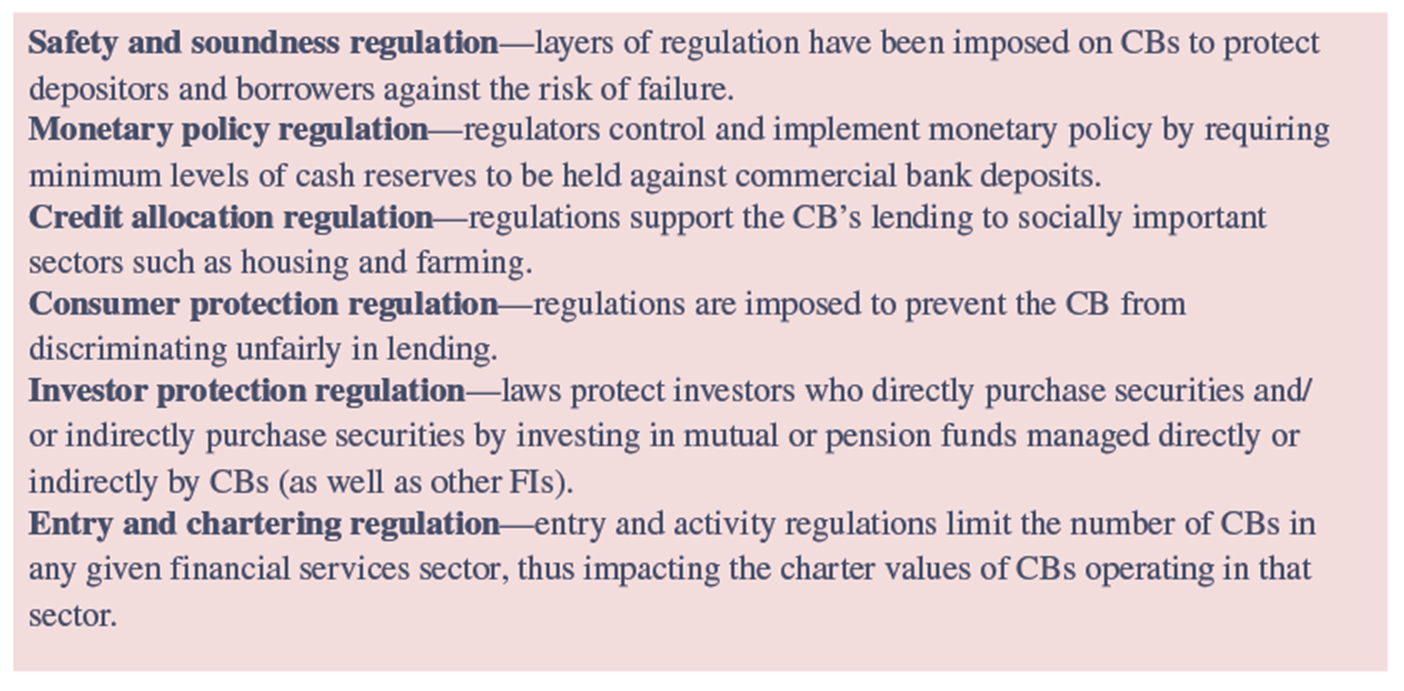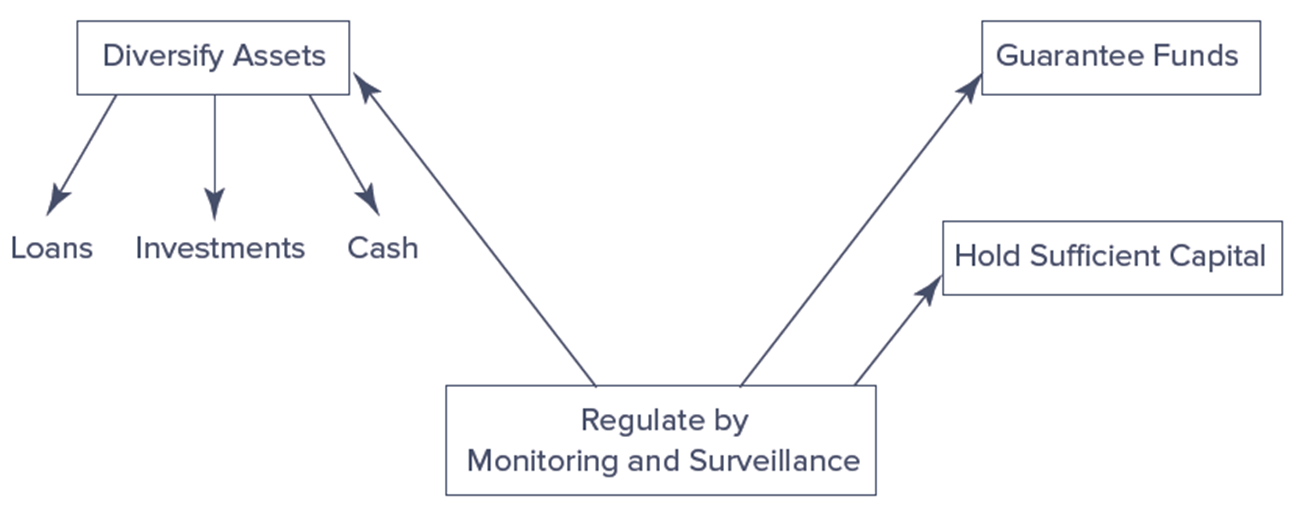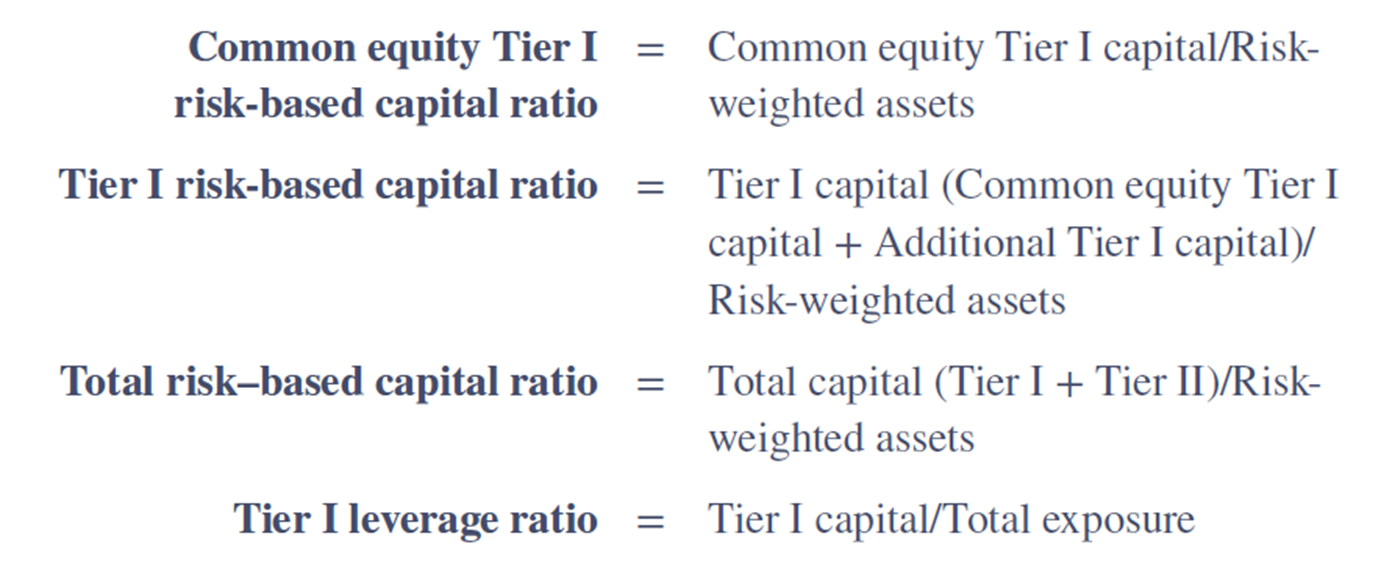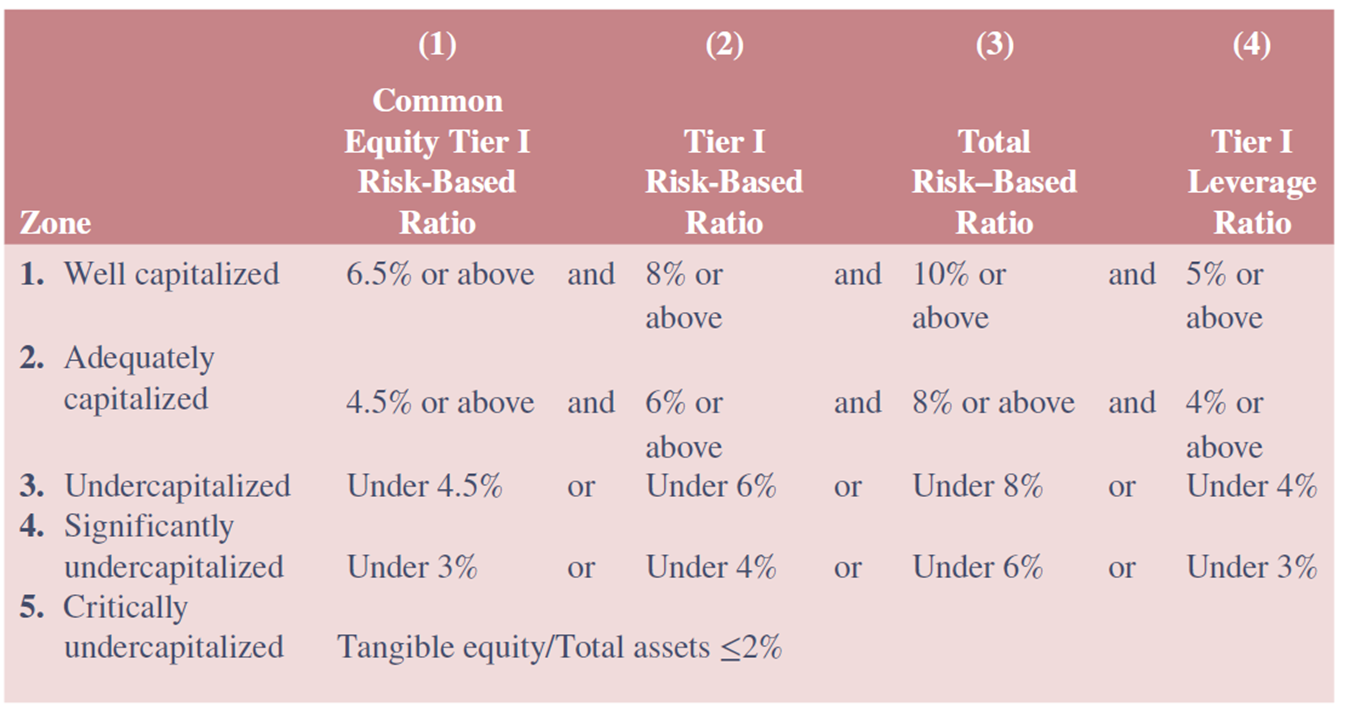Institutions Ch 13 (Done)
1/66
Earn XP
Description and Tags
Regulation of Commercial Banks
Name | Mastery | Learn | Test | Matching | Spaced |
|---|
No study sessions yet.
67 Terms
FIs provide many vital services to important sectors of the economy, such as the following:
Information services
Liquidity services
Price-risk reduction services
Failure to provide these services or a breakdown in their efficient provision can be costly to both the ultimate providers (households) and users (firms) of funds
Accordingly, commercial banks (CBs) are regulated at the federal (and sometimes state) level
Six types of regulations seek to enhance the net social benefits of commercial banks’ services to the economy:
Safety and soundness regulation
Monetary policy regulation
Credit allocation regulation
Consumer protection regulation
Investor protection regulation
Entry and chartering regulation
Regulations
_____________ can be imposed at the federal or the state level and occasionally at the international level, as in the case of bank capital requirements
Areas of CB Specialness in Regulation

lLayers of protective mechanisms balance a CB’s profitability against its solvency, liquidity, and other types of risks

First layer
__________ of protection is the diversification of assets
Second layer
___________ of protection concerns the minimum level of stockholder capital or equity funds that the owners of a CB need to contribute to the funding of its operations
Third layer
__________ of protection is the provision of guarantee funds such as the Depositors Insurance Fund (DIF) for banks
Mitigates a rational incentive depositors otherwise have to withdraw their fund at the first hint of trouble
Fourth layer
____________ of regulation involves monitoring and surveillance
Involves on-site examination of the CB by regulators as well as the CB’s production of accounting statements and reports on a timely basis for off-site evaluation
without costs
Regulation is not __________ for those regulated
Difference between the private benefits to a CB from being regulated (e.g., insurance fund guarantees) and the private costs it faces from adhering to regulation (e.g., examinations) is its net regulatory burden
Higher the net regulatory burden on CBs, the smaller are the benefits of being regulated compared to the costs of adhering to regulations from a private (CB) owner’s perspective
net regulatory burden
Difference between the private benefits to a CB from being regulated (e.g., insurance fund guarantees) and the private costs it faces from adhering to regulation (e.g., examinations) is its ______________________
2010 Wall Street Reform and Consumer Protection Act
Signed into law by President Obama in July 2010
2010 Wall Street Reform and Consumer Protection Act
Set forth reforms to meet five key objectives:
Promote robust supervision and regulation of financial firms
Establish comprehensive supervision of financial markets
Protect consumers and investors from financial abuse
Provide the government with the tools it needs to manage financial crises
Raise international regulatory standards and improve international cooperation
Dodd-Frank rules
On May 22, 2018, Congress passed the Economic Growth, Regulatory Relief, and Consumer Protection Act (EGRRCPA), a partial rollback of some of the ____________
Monetary policy regulation
Regulators commonly impose a minimum level of required cash reserves to be held against deposits, or inside money
CBs often view required reserves as similar to a tax and as a positive cost of undertaking financial intermediation
Credit allocation regulation
Regulations support the CB’s lending to socially important sectors, such as housing and farming
May require a CB to hold a minimum amount of assets in one particular sector of the economy or to set maximum interest rates, prices, or fees to subsidize certain sectors
Qualified thrift lender (QTL) test requires savings institutions to hold 65 percent of their assets in residential mortgage-related assets to retain a thrift charter
discriminating unfairly
Regulations are imposed to prevent the CB from ______________ in lending
Community Reinvestment Act (CRA) of 1977
CRA ratings range from outstanding to substantial noncompliance, and examinations for compliance have become increasingly rigorous
Home Mortgage Disclosure Act (HMDA) of 1975
Especially concerned about discrimination on the basis of age, race, sex, or income
Consumer Financial Protection Bureau (CFPB)
Created as part of the financial services overhaul bill passed in 2010 to protect consumers from unfair, deceptive and abusive practices
Example of CFPB oversight occurred in September 2016 when Wells Fargo Bank was ordered to pay $185 million in fines and penalties to settle “the widespread illegal practice of secretly opening unauthorized deposit and credit card accounts”
Considerable number of laws protect investors who use commercial banks directly to purchase securities and/or indirectly to access securities markets through investing in mutual or pension funds managed by CBs
Various laws protect investors against abuses such as insider trading, lack of disclosure, outright malfeasance, and breach of fiduciary responsibilities
Securities Act of 1933 and 1934
Investment Company Act of 1940
Wall Street Reform and Consumer Protection Act of 2010
Entry into commercial banking is regulated, as are activities once a CB has been established
Increasing/decreasing the cost of entry into a financial sector affects the profitability of firms already competing in that industry
Regulations define the scope of permitted activities under a given charter
For example, current regulations allow commercial banks to perform activities traditionally performed only by insurance companies and investment banks
charter value
Barriers to entry and regulations pertaining to the scope of permitted activities affect a CB’s ___________ and the size of its net regulatory burden
U.S. commercial banks may be subject to the supervision and regulations of as many as four separate regulators
Federal Deposit Insurance Corporation (FDIC)
Office of the Comptroller of the Currency (OCC)
Federal Reserve (FR)
State bank regulators
Facets of regulatory structure
Regulation of the overall operations
Regulation of product and geographic expansions
Provision and regulation of deposit insurance
Balance sheet regulations
U.S. financial system has traditionally been segmented along product lines
Commercial banking involves deposit taking and lending
Investment banking involves underwriting, issuing, and distributing securities
Commercial banking
____________________ involves deposit taking and lending
Investment banking
_____________________ involves underwriting, issuing, and distributing securities
Glass-Steagall Act
The __________________ imposed a rigid separation between commercial and investment banks
Act defined three major exceptions to this separation
By 1987, commercial banks could engage in limited investment banking activity through Section 20 affiliates
In 1999, the Financial Services Modernization Act (FSMA) repealed Glass-Steagall barriers between commercial banking and investment banking
Banking and insurance
Bank Holding Company Act (BHCA) of 1956 and the Garn-St. Germain Depository Institutions Act of 1982 restricted insurance companies from owning or being affiliated with full-service banks
FSMA of 1999 allowed bank holding companies to open insurance underwriting affiliates and permitted insurance companies to open banks and securities firm affiliates
Commercial banking and commerce
BHCA of 1956 required BHCs to divest themselves of nonbank-related subsidiaries over a 10-year period and effectively restricted acquisitions of banks by commercial firms
FSMA of 1999 changed restrictions on ownership limits imposed on financial services holding companies
Nonbank financial service firms and banking
Relative to the barriers separating banking and either securities, insurance, or commercial sector activities, the barriers among nonbank financial service firms and banking are generally much weaker
Activities of nonbank financial institutions (NBFIs) have been termed shadow banking
December 2022 report put assets of shadow banks worldwide at $152 trillion, at the end of 2021
These shadow banks continue to be unregulated by the federal government
FSOC final interpretive guidance give priority to identifying activities that present systemic risks and seek to control risks by making recommendations to primary regulators
shadow banking
Relative to the barriers separating banking and either securities, insurance, or commercial sector activities, the barriers among nonbank financial service firms and banking are generally much weaker
Activities of nonbank financial institutions (NBFIs) have been termed ______________
December 2022 report put assets of shadow banks worldwide at $152 trillion, at the end of 2021
These shadow banks continue to be unregulated by the federal government
FSOC final interpretive guidance give priority to identifying activities that present systemic risks and seek to control risks by making recommendations to primary regulators
Geographic expansions can have several dimensions:
Domestic
Within a state or region
International (participating in a foreign market)
Regulatory factors impacting geographic expansion
Restrictions on intrastate banking by commercial banks
By 1994, only one state (Iowa) had not deregulated intrastate banking
Restrictions on interstate banking by commercial banks
McFadden Act, passed in 1927 and amended in 1933
Douglas Amendment to the Bank Holding Company Act, 1956
By 1994, all states but Hawaii had passed some form of interstate banking law or pact
Regulatory factors impacting geographic expansion
Riegle-Neal Interstate Banking and Branching Efficiency Act of 1994
Allowed U.S. and foreign banks to branch interstate by consolidating out-of-state bank subsidiaries into a branch network and/or by acquiring banks of individual branches of banks through acquisitions or merger
Result of this is that full interstate banking is a reality in the U.S.
Relaxation of the branching restrictions, along with recognition of the potential cost, revenue, and risk benefits from geographic expansions, are major reasons for the recent merger wave (and increased consolidation) in U.S. banking
Federal Deposit Insurance Corporation (FDIC)
Created in 1933 in the wake of the banking panics of 1930-1933 to maintain the stability of, and public confidence in, the U.S. financial system
System worked well until 1979; from October 1979 to October 1982, the Fed changed its monetary policy strategy by targeting bank reserves rather than interest rates to lower the underlying rate of inflation (FDIC Slide)
Led to a sudden and dramatic rise in interest rates, with T-bill rates rising as high as 16 percent
Resulted in DIs facing negative interest spreads and being forced to pay more competitive interest rates on savings deposits to avoid disintermediation
Partly to overcome the effects of rising interest rates and disintermediation on the DIs, Congress passed regulations that expanded DIs deposit-taking and asset investment powers
For a small, but significant, group, this gave them the opportunity to take more risks in an attempt to return to profitability
Problems were exacerbated by a policy of regulatory forbearance, a policy of not closing economically insolvent depository institutions, but allowing their continued operation
regulatory forbearance
Problems were exacerbated by a policy of ___________________, a policy of not closing economically insolvent depository institutions, but allowing their continued operation
potential insolvency
FDIC Improvement Act (FDICIA) was passed in December 1991 to restructure the bank insurance fund and to prevent its ______________
However, the financial market crisis hit the banking industry very badly
During the worst of the crisis (2008-2011), 355 DIs failed at a total cost to the FDIC of $81.7 billion
FDIC and the federal government took several steps to ensure the fund would have sufficient resources to deal with any and all DI failures
From 2013 to 2019 the number of bank failures continued to drop with FDIC reserves becoming positive in the second quarter of 2011 and rose to $128.2 billion by December 31, 2022
Federal Savings and Loan Insurance Corporation (FSLIC) insured the deposits of savings institutions from 1934 to 1989
Savings institution failures in the 1980s led to an insolvent FSLIC by 1989
Financial Institutions Reform, Recovery, and Enforcement Act (FIRREA) of 1989
Restructured savings association fund and transferred management to the FDIC
Restructured savings association insurance fund was renamed the Savings Association Insurance Fund (SAIF) and restructured bank insurance fund was renamed the Bank Insurance Fund (BIF)
FDIC introduced risk-based deposit insurance program on January 1, 1993
In 1996 (for BIF-insured DIs) and 1997 (for SAIF-insured DIs) the fee structure for deposit insurance was changed so that the healthiest institutions paid 0 cents per $100 deposits, while the riskiest paid 27 cents per $100 of deposits
By December 2005, 94.6% of all BIF-insured DIs (and 93.9% of all SAIF-insured DIs) paid the statutory minimum premium
In January 2007, FDIC began calculating deposit insurance premiums based on a more aggressive, risk-based system
A restoration plan for the DIF requires the FDIC to restore DIF reserve ratio to 1.35 percent under Dodd-Frank Act
Regulations on commercial bank liquidity
Holding relatively small amounts of liquid assets exposes a CB to increased illiquidity and insolvency risk
Regulators impose minimum liquid asset reserve requirements on CBs
Requirements depend on the illiquidity risk exposure perceived for the CB’s type and other regulatory objectives that relate to minimum liquid asset requirements
Banks in the U.S. must hold the following “target” minimum reserves against net transaction accounts:

Regulations on capital adequacy (leverage)
Basel Agreement (i.e., Basel I) imposed risk-based capital ratios on banks in major industrialized countries
Basel II of 2006 allowed for a range of options for addressing both credit risk and operational risk, but the financial crisis of 2008-2009 revealed weaknesses with Basel II
Basel 2.5 was passed in 2009 (effective 2013) and updated capital requirements on market risk from banks’ trading operations
Basel III was passed in 2010 (fully effective in 2019) and the goal is to raise the quality, consistency, and transparency of the capital base of banks to withstand credit risk and to strengthen the risk coverage of the capital framework
Basel Agreement
_______________ (i.e., Basel I) imposed risk-based capital ratios on banks in major industrialized countries
Under Basel III, DIs must calculate and monitor four capital ratios:

Specifications of Capital Categories for Prompt Corrective Action

risks
In measuring a DI’s capital adequacy, its capital is the standard by which each of these ________ is measured
Risk-weighted assets
____________________ are made up of risk-weighted on- and off-balance sheet assets
capital conservation buffer
Basel III introduced a __________________ designed to ensure DIs build up a capital surplus
countercyclical capital buffer
Basel III also introduced a ________________________ that may be declared by any country experiencing excess aggregate credit growth
global systemically important banks
BIS imposed an additional common equity Tier I surcharge on ___________________________
Overseas Direct Investment Control Act of 1964
_______________________________________ restricted U.S. banks’ ability to lend to U.S. corporations that wanted to make foreign investments
Eurodollar market
Offshore funding and lending in dollars created the beginning of the _____________
USA Patriot Act of 2001
__________________________ amended the Bank Secrecy Act in establishing standards for screening customers who open accounts at financial institutions
International Banking Act (IBA) of 1978 declared foreign banks are to be regulated the same as national domestic banks
Foreign banks were required to hold Federal Reserve-specified reserve requirements if their worldwide assets exceeded $1 billion
Foreign banks were subject to Federal Reserve examinations, as well as the McFadden and Glass-Steagall Acts
Foreign Bank Supervision Enhancement Act (FBSEA) of 1991 extended federal regulatory authority over foreign banking organizations in the U.S.; five main features of the act:
Entry
Closure
Examination
Deposit taking
Activity powers